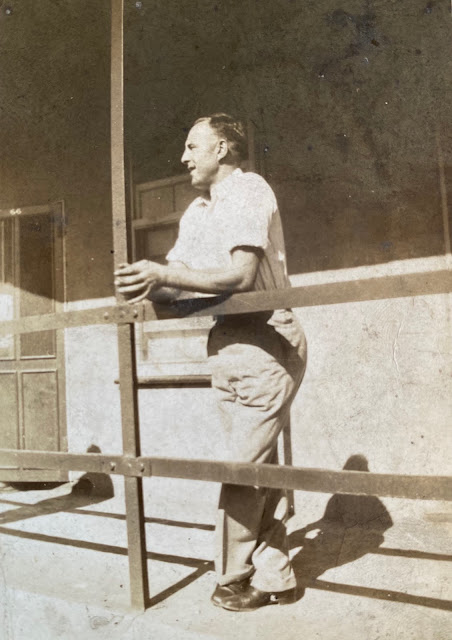Updated 16 January 2023
The Souvenir Edition, 1st Sailing to Australia, tells us that, while Captain Pedersen sailed the ship, another Captain, in the US Army, ran life for its passengers. He was Valentine Pasvolsky of Lakewood, New Jersey. The Souvenir Edition has this to say about him:
Captain Valentine Pasvo1sky has been in the US Army for quite a long time and plans to remain for some time more. He has been with the USAT "General Heintzelman" since it was assigned to the DP program, prior to that he was on troop transport duty, Although a registered Civil Engineer, at the present time his job is Transport Commander, a position comparable to that of Army Post Commander, the (USAT) “General Heintzelman" his military post. A resident of Lakewood, New Jersey, he is married and has four children, two boys and two girls. The Captain is quite familiar with all the States and many foreign countries. For Australia, however, in common with passengers, he is heeded for the first time. On frequent occasions the Captain has been in close contact with Baltic people — Estonians, Latvians and Lithuanians, and speaks most highly of them. In speaking of the group now aboard, he is highly pleased with the co-operation shown in maintaining order, cleanliness, and everything (else) that makes for an all round pleasant trip (and) extends his best wishes to all in your new endeavours and new homes.
 |
| Valentine Pasvolsky as portrayed in the Souvenir Edition |
Captain Pasvolsky was the man who supplied the headline for the West Australian newspaper's report on 29 November 1947 of the arrival of the Heintzelman. "'The Pick of the Bunch' from Europe" led the report.
Captain Pasvolsky explained that the ship had been under US Army discipline: he was in charge of the passengers and a US Army staff of 12. This was the fifth trip the Heintzelman with displaced persons from Europe, the other trips being to Brazil and Canada.
"These people are the pick of the bunch", Pasvolsky said. "Their conduct has been excellent, their discipline has been remarkable, their physique is good, they are clean, and generally their educational standard seems high."
Once again, it's Ancestry.com which provides much more information about Captain Pasvolsky. Rather than detailing Ancestry's multiple sources below, I have created a Pasvolsky family tree on Ancestry. This tree should be accessible at https://www.ancestry.com/family-tree/tree/180672966/family/familyview?cfpid=362349000400, although you may need to set up a free Ancestry.com Registered Guest account to view it.
 |
| Valentine Pasvolsky on 20 November 1948, at the wedding of his younger daughter, the first of his children to marry Source: Ancestry.com |
His family had lived in New Jersey from at least 1917, with Valentine marrying there in 1922. In contrast to his immigrant status, his wife was a Mayflower descendent. She was Ellen Isabel Stoughten, known as Nellie. Together they actually had 5 children, with one of the 3 girls dying in infancy. Although the children were described as "two boys and two girls" in the Souvenir Edition, the oldest was already aged 24 at the time of our Heintzelman voyage, while the youngest was aged 18. That is to say that they were of a similar age to many of the refugee passengers of whom Valentine was in charge.
 |
| Captain Valentine Pasvolsky (standing, centre) with his family, probably at home in New Jersey, possibly taken in 1944 Source: Ancestry.com |
 |
| Captain Pasvolsky's wife Nellie with their oldest child, Dick, probably taken on the same day as the previous photo, with Nellie perhaps in Red Cross uniform; the background may well be their New Jersey home Source: Ancestry.com |
Valentine did stay in the US Army for another 12 years, in fact, retiring at the age of 60 in 1959, with the rank of Major. It was then that his second career as a collector could flourish.
He had been collecting North American Indian wumpum and medals since early in his Army life. In the course of this, he had acquired related coins as well. A New Jersey tercentenary exhibition in 1964 earned him first prize for his display of early American money.
He was highly regarded by fellow numismatists for his willingness to help them organise and to share information. In 1974, Val Pasvolsky received a Numismatic Ambassador award from the American Numismatic Association.
In 1975, the Utah Numismatic Society awarded him a plaque in recognition that his display for them marked the 50th American State in which he had exhibited. Also in 1975, the cover of the first issue of the Garden State Numismatic Association Journal honoured him (Garden State being the nickname for New Jersey as well as the Australian state of Victoria). Current and past officials of the American Numismatic Association attended a testimonial dinner organised in his honour that year to present him with a medal of merit.
His collecting extended to North and South American Indian art. Val began exhibiting his collection at his home, calling it the Indian Village Museum and Trading Post of Lakewood. The Museum occupied three rooms on the ground floor. Val enjoyed sharing his vast knowledge with his visitors. He also exhibited select items from his collection at various events, often giving presentations donned in full Indian regalia.
 |
| Inside the Indian Village Museum and Trading Post of Lakewood Source: Heritage Auctions Website |
 |
| This Sioux boy's beaded shirt from the Pasvolsky Collection was sold for USD 75,000 in 2013 Source: Heritage Auctions Website |
Val's father is recorded as working as an editor, perhaps of Russian language publications. Another son, Leo, was an economist, journalist and public servant. As a personal assistant to the then US Secretary of State during World War II, Leo Paslovsky is credited with writing the final version of the Charter of the United Nations.
ALL SOURCES listed on my Ancestry.com pages for members of the family.





















